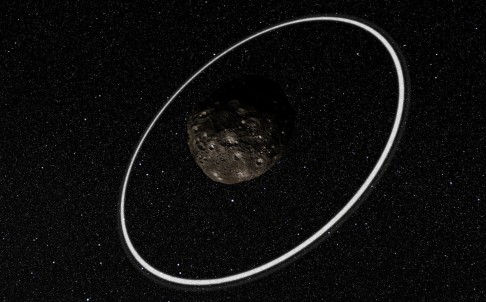Astronomers find two rings around asteroid Chariklo
PUBLISHED : Thursday, 27 March, 2014, 10:58pm
UPDATED : Thursday, 27 March, 2014, 10:58pm
Agence France-Presse in Paris

Astonished astronomers say they have found rings around an asteroid, the smallest object known to have this feature and only the fifth after Jupiter, Saturn, Uranus and Neptune.
Observations were first made last June leading to the detection of the twin rings around a rock called Chariklo, illustrated above, as it passed in front of a star, scrutinised by seven telescopes dotted over a 1,500-kilometre stretch of South America.
As expected, the star seemed to vanish for a few seconds as Chariklo blocked its light - a phenomenon known as occultation, an international team reported in the science journal Nature.
But the mini-eclipse was much more than the astronomers were expecting.
"A few seconds before, and again a few seconds after the main occultation, there were two further very short dips in the star's apparent brightness," the European Southern Observatory said.
"Something around Chariklo was blocking the light!"
It turned out to be two narrow, dense rings, a feature believed to be limited to the four giant planets of our solar system.
"We weren't looking for a ring and didn't think small bodies like Chariklo had them at all, so the discovery, and the amazing amount of detail we saw in the system, came as a complete surprise," said Felipe Braga Ribas of Brazil's National Observatory.
Chariklo, a lumpy rock discovered in 1997 and named after a water nymph in Greek mythology, orbits the Sun between Saturn and Uranus, more than a billion kilometres from earth.
Agence France-Presse
